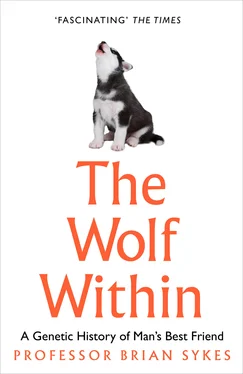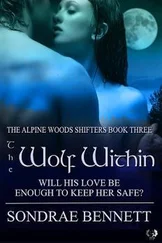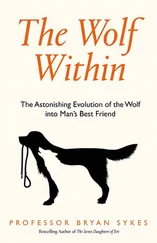‘Is there any other point to which you would wish to draw my attention?’ asks Gregory.
‘To the curious incident of the dog in the night-time,’ replies Holmes.
‘The dog did nothing in the night-time,’ responds Gregory.
‘That was the curious incident,’ replies Holmes.
9
Why Didn’t Shaun Ellis Get Eaten by Wolves?
If there was anything in the notion of an ancient pact between man and wolf that preceded ‘domestication’ then the best way to find out was to meet some wolves.
In my research for this book I had read an account by a man who had managed to forge a great friendship between himself and a pack of wild wolves. Although very far removed from the Upper Palaeolithic when we, I imagined, first began to hunt with wolves, I wondered whether the basic instincts on which that relationship was based would still be there.
Shaun Ellis, the co-author of The Man who Lives with Wolves , describes how, as a young man, he had become instantly entranced by the sight of a captive wolf.1 Shaun’s transforming experience had happened in a wildlife park near Thetford, not far from his childhood home in Norfolk. The brief encounter changed Shaun’s life entirely and led him eventually to devote himself to wolves. He moved to the USA to work as a volunteer at a wolf rehabilitation centre in Idaho and later set out on his own to find and live among a wild wolf pack.
I heard that he had returned from Idaho and, now in his early forties, was living on a farm in Cornwall. I knew I needed to meet Shaun as soon as possible and, if he would allow it, interview him. Fortunately, he agreed, and on a cold and dark Friday in December, my wife Ulla and I set off on the long train journey to Lostwithiel, where Shaun and his partner Kim now live in the company of a small pack of wolves. We settled into the cosy parlour of the farmhouse, at least partially revived with a hot cup of tea.
I began by asking Shaun about his childhood on his grandfather’s farm deep in the Norfolk countryside, leading up to that first encounter with the wolf. An only child, Shaun had been raised mainly by his grandparents, his mother having to work full-time to support the family. His grandfather in particular had been an important influence, fostering Shaun’s growing love of the outdoors. They took frequent walks together with their dogs in the woods and across the fields, hunting rabbits. Always a reluctant pupil, Shaun left school at 15 and had various jobs including a spell in the army.
A free and easy man, his life continued with no definite purpose until the day he took a bus to the local zoo in Thetford. Wandering around, he came upon the wolf enclosure. There, only a few metres away, stood a fully-grown wolf looking straight at him. Here, right in front of him, was the savage killer he had been taught to fear. As he stared back into its golden yellow eyes he felt as though it was touching his very soul. It was as if the creature could read his deepest thoughts and somehow understood him better than any human had ever done. In that instant Shaun’s future path through life was fixed. He has devoted himself ever since to understanding and to helping the rest of us to understand and appreciate what these wonderful creatures are really like. He was, however, sufficiently self-aware to realise that the wolf probably looked at every visitor in the same way.
No matter, over the next years Shaun’s life revolved entirely around wolves. Lacking any professional qualifications and viewed with suspicion by some professional biologists, Shaun has lived with wolves, has brought up a family of wolves, and in the process he felt as though he had almost become a wolf himself. For two years he was alone with a pack of wild wolves in the forests of Idaho. He had travelled to that part of America to work at a wolf education centre where a captive pack was kept in order to educate visitors and to disabuse them of the wolf’s thoroughly undeserved reputation for savagery. After a while Shaun realised that he could never really understand the enigmatic animal only by working with captive wolves, so he packed his rucksack and set off alone into the forest.
Shaun knew there were wolves living there – they migrated every year down from Canada and across Montana into Idaho. But he did not know exactly where they would be. Three months passed before he saw any sign of a wolf. Then, one day, he saw the unmistakable paw print of a large male in the soft mud by the side of a waterhole. In the weeks that followed he heard the chilling chorus of a howling pack drifting through the night.
Eventually he caught a glimpse of his first wolf, a large black male, as it crossed the track some hundred metres ahead. The wolf looked at him briefly before trotting off into the forest. Weeks passed and Shaun saw the black wolf more regularly as if it were sizing him up, whether as a meal or a mere curiosity he could not be certain. A few weeks later, the black wolf reappeared with four others, two males and two females – a real pack. Slowly, day by day, week by week, the wolves became more confident until one day the big male came up to Shaun, sniffed him and suddenly nipped him just below the knee.
Although it was painful, Shaun knew from his experience with captive wolves that this was not a bite in anger. Rather like shaking hands, it was a way for the wolf to introduce himself.
All wolf packs maintain a strict hierarchy. As a rule, only the dominant pair, the alpha male and female, breed, while the other wolves are given supporting roles in the pack. Generally speaking, the other wolves are the siblings and offspring of the alpha pair. Whereas the alpha female is the undisputed leader of the pack, it falls to the beta animals, one rung down in the hierarchy, to maintain discipline and to organise the defence of the pack when it is threatened. It was the beta male, the enforcer, that sized Shaun up and gave him that painful bite, not in anger but as an introduction. The encounters between Shaun and the wolves became more and more frequent over the next weeks. After six weeks he felt that he had been accepted by the pack as an ‘honorary wolf’. He was given the job of what he describes as a diffuser, a calmer of nerves. Like any other family, wolf packs can argue, and they have sharp teeth and claws with which to make a point. Shaun’s role, as he saw it, was to make sure these petty squabbles did not get out of hand.
‘Why,’ I asked him, ‘were you not attacked?’
‘Because I was useful. Also I suspect because the wolves could learn from me, something they needed to do, surrounded as they were by wolf-hating bloodthirsty hunters.’
Shaun’s joy at being accepted by the pack was severely tested one day when, without warning, the beta male suddenly lunged at him and knocked him to the ground. The wolf stood over him, fangs bared, and growling. Here is Shaun’s account of his terrifying experience.
I suddenly felt this was the end. Up to then I had trusted them completely not to harm me, but in that instant I remember thinking OMG they are this creature after all. They are going to kill me. He kept pushing me back with nips and growls into a hollowed-out tree then stood outside snarling. What a fool I’ve been, I thought to myself, they have been biding their time “fattening me up for Christmas” so to speak. But the fatal attack never came. I was there pinned down for an hour and a half then, just as suddenly as the attack had begun the wolf backed off. He called me with a low-pitched whimper and went into a very appeasing body position as if to apologise. It was as if it had suffered some kind of psychosis, turning into a killing machine and then back again.
It took me a while to come out, and that is when he led me down the path to where I was going. There by the stream were the unmistakable marks left behind by a huge bear. Not only did he save my life but the episode reinforced my original belief that I should always trust them.
Читать дальше












